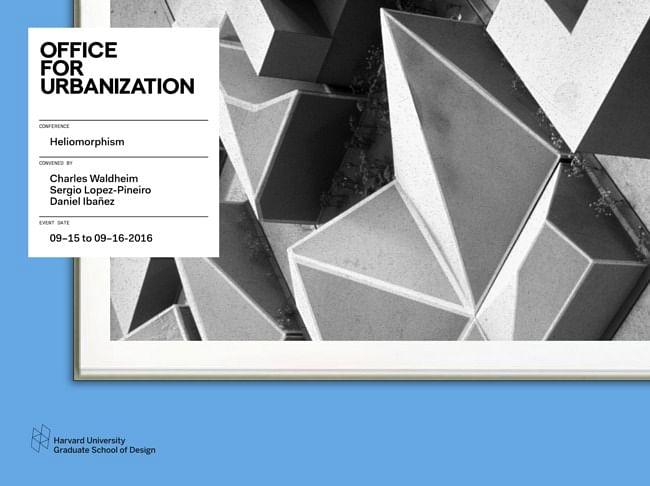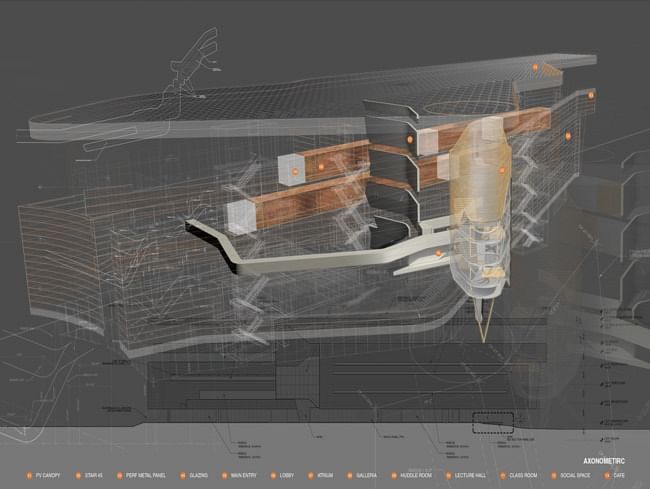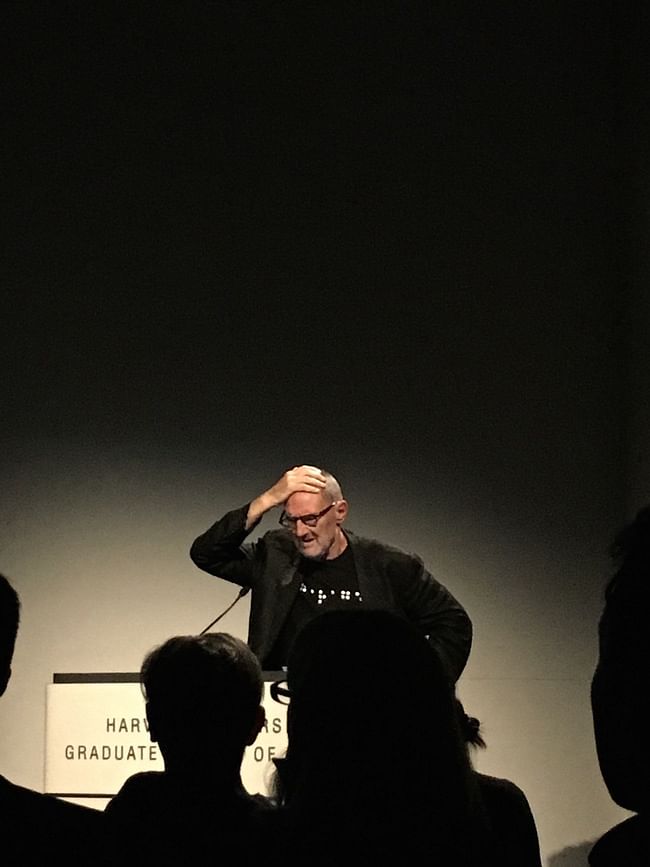
We once knew the world was flat.
We once knew earth was the center of the universe.
We once knew the sun was the center of the universe.
We once knew the Milky Way was the center of the universe.
Maybe the 3rd is not so far off in the end.
The Harvard Graduate School of Design (GSD) officially launched its new research focused arm, Office for Urbanization, with a conference titled 'Heliomorphism'. Research has a long and varied history at the GSD and of course at Harvard in general. Exploiting and creating these opportunities for collaboration and exploration of disciplinary topics are at the highest aspirations for the Office.

Its goal is thus to become a transdisciplinary initiative designed to focus the intellectual and practical capabilities of the School on a range of applied design research projects, attendant to the contemporary city. While the school itself already contains a plethora of Design Labs, Groups, Lectures and conferences, the Office of Urbanization hopes to distinguish itself by focusing on research that looks to be sponsored in the realm of design.
Landscape architecture professor Charles Waldheim, the conference organizer, added that the Office “proposes to revise and extend the ecological urbanism agenda by returning to solar performance. Recent projects by a number of leading architects and urbanists have suggested new forms of urban order through solar orientation. In many of these projects, designers correlate the shape of the city to a complex and contradictory economy of solar performance.”
Dean Mohsen Mostafavi cemented this in his comment by stating “How do we do research in the realm of design, without the implication of aesthetics? History, Technology, Theory, have all had their long tradition of scholarship and yet design practice has not had this out, this ability to do scholarly research on the same level... while I do not promise that this will work...I can promise that it is promising work”.
Day one of the two-day Heliomorphism conference was filled with colloquiums, student presentations and panels, which were brought to a close by a set of keynote presentations by Pritzker Prize winning architect Thom Mayne of Morphosis Architects and Chicago-based architect Jeanne Gang of Studio Gang on Thursday Night.

Hyde Park Tower Condominium. Circulation and Environmental Systems. © Studio Gang
Jeanne Gang presented a series of works, from Aqua and Boathouse in Chicago, to her Solar Carve Tower in New York, which all, as she states “…allowed her to return to her passion of the environment”. As Gang made her way through the different interventions it became clear that “the sun was clearly the center of her universe”. Every element of her work dutifully aligned itself with some aspect of the solar conversation; from the diagrams which playfully represented the sun as a caricature, to her naming of the projects themselves, it seems to be that the sun has become the zeitgeist of Studio Gang.
As Thom Mayne of Morphosis took the podium, the focus shifted from the sun, erupting into his growth as an architect over the course of his career; and development from himself, to the city, to the environment. Mayne was able to present work starting from his early projects, such as Caltrans District 7 Headquarters in Los Angeles and the San Francisco Federal Building, to his recent work including the Giant Interactive Group Corporate Headquarters in Shanghai and the upcoming Bloomberg Center in New York, without once drawing a sun. His presentation produced a slow build-up of tools and formal operations that absorbed the conversation of the environment in its production.

Drawing of Bloomberg Center. Circulation and Environmental Systems. © Morphosis Architects
As Thom stated, “the restrictions became absorbed by the work, it became a byproduct, it becomes something you no longer have to think about or claim.” This culmination in design and environmental research was realized in various projects but his focal point became the San Francisco Federal Building. Here, environment and geometry were able to conceptually and formally blend. The presentation thankfully finally stepped out of the shadow of a Heliomorphic conversation and all its undefined or restricted jargon, and into a discussion of the architectural discipline thus becoming the day’s saving light.
Thom’s approaches in his career were not without their own criticisms. As Thom enthusiastically recalled, at the time of the San Francisco Federal Building’s construction, “Can I say fuck up here?… Well, they said here comes this LA guy to FUCK UP OUR CITY.” Fast forward and it could be said that such an endeavor lead to his receiving architecture’s highest distinction, the Pritzker Prize.

What came of day one was a complete gradient of the realm in which architecture of the environment, and its specific research variations thereof, can exist. Studio Gang, which revolves on the figure of the sun, and Morphosis Architects, which has learned through time to absorb the sun and use it to cast its own shadow on its own environment.
The day produced an eclectic display of possibilities, explorations and architectural endeavors, but with it minimal personality and declarations of nothing really of value or risk. Design research needs to culminate into more than high value Scrabble words and caricatures of the environment. While revived interest and focus of research in the contemporary design world is needed, it should desire and strive to be more than “traditional,” or worse, a curated display of stripped down studio aesthetics and its creativity.
9 Comments
Sounds like an awesome circle-jerk session
BYOTowel.
“How do we do research in the realm of design, without the implication of aesthetics? "
WTF?
Pretty safe one!
The Harvard Office for Urbanization sounds interesting, but I dislike the whole sun diagram approach to design, where Gang (or BIG) use a sun direction to find some false thesis for a building shape...it falls under the same rubric as "design thinking" where basic preliminarily studies serve as some kind of be all end all of design. Pseudoscience Bullshit!
I love Jeanne and I think her and Thom's work is amazing and truly important. Charles is...Charles. Dude, there already are beautiful precedents for heliomorphic urbanism. Tenochtitlan, for one. Closer to home, here in Illinois (where Charles used to teach) is Cahokia. 1,000 years ago Cahokia, capital of the Mississippi Nation, just across the Big Muddy from St. Louis, was a city larger than London. That's right; at the time of the Norman Conquest there was a heliotropic city in North America from which approximately 60% of the continent was ruled. The Temple of the Sun there was the tallest manmade structure in North America until the completion of the US Capitol dome. There was a complex at the base of the temple now called "Woodhenge" which was, as one would expect, a tree-trunk-based, more finely-calibrated solar registry - but the primary monuments of the entire city were also organized around the movement of the sun.
That said, there is important work to be done in getting Americans to start paying attention to the notion that the sun is a thing, and that basics like which way your house is turned might be something to pay attention the next time a new ex-urb sprouts up.
edavis7@saic.edu
Considering most houses get built on platted ground it seems like the ability to manipulate a plan to take in the light optimally would be more important than rotating a house, which isn't always possible. It's a great idea, just not sure what's with the wall of glass in the diagram.
Praise to academia for repeatedly taking in Charles W. and give him shelter to noodle.
Thom Mayne IS the sun. That said, these folks are all playing watchmakers / designers when we know by now that evolution runs on natural selection and gene-jumping. Look to Ai, a mystery to these old-timers, for the forces that will be shaping our built environment in the remainder of this century. Harvard tries too hard to sciencize everything - a Harvard problem throughout all disciplines explored there. Recommended reading for these inspired, ultra-talented, immensely credentialed now iconic geezers: "Against Method" by Paul Feyerabend. Neither life nor workable architecture is designed - it evolves, so.....search for the sources of powerful, unexplored ideas re: forces in play. Architecture students ought to study a bit of biochemistry and evolutionary theory. Another useful book for architects is Stephen Jay Gould's doorstop: "The Structure Of Evolutionary Theory"
Block this user
Are you sure you want to block this user and hide all related comments throughout the site?
Archinect
This is your first comment on Archinect. Your comment will be visible once approved.